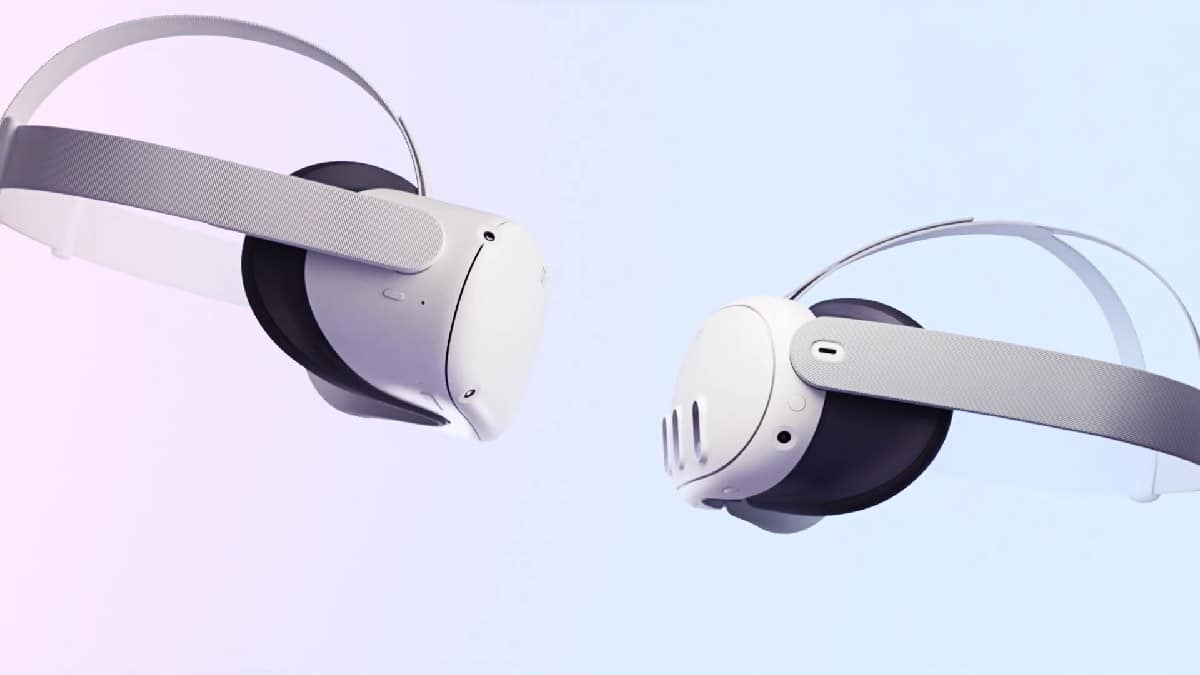Video Gamer is reader-supported. When you buy through links on our site, we may earn an affiliate commission. Prices subject to change. Learn more
We’re going to take a deep dive into the Meta Quest 3 vs Meta Quest Pro to dissect what the differences are between these two iconic headsets.
With the Meta Quest 3 announced by Zuckerberg in June this year, the anticipation has only been building. Following the September Connect event, Meta has spilled all about the device, and now that the Meta Quest 3 pre-order is now live we’ve had a glance at all the improvements and breakthroughs of the new VR headset.
The Meta Quest Pro, on the other hand, was released in October 2022. As one of the best VR headsets, it brought a lot to gaming with its brilliant gaming specs, crisp display, and versatility. Even in a comparison between the Meta Quest Pro vs the PSVR 2, it reigned supreme.
For now though, let’s put these two headsets tête-à-tête and see what the differences are. We’ve broken down our comparison into different sections to make it simple for you.
Meta Quest 3 vs Meta Quest Pro – Specs
| Meta Quest 3 | Quest Pro | |
| Chipset | Snapdragon XR2 Gen 2 | Qualcomm Snapdragon XR2+ |
| Display resolution | 2064 x 2208 pixels per eye | 1800 x 1920 per-eye |
| Storage | 128 GB, 512 GB | 256 GB |
| RAM | 8 GB | 12 GB LPDDR5 |
| Battery life | 2.2 hours of usage on average | 2-3 hours |
| Size | 184 mm x 160 mm x 98 mm | 5.1 x 2.8 x 2.4 inches |
| Weight | 515 grams | 722 g with headstrap |
| Passthrough | Full-color passthrough | Color passthrough |
The Quest 3’s specs show it offers an impressive performance at its price range, especially if you were to compare between the Meta Quest 3 and the Meta Quest 2. The 128 GB model is priced at $499, while the much larger 512 GB variant comes in at $649. Despite offering these two storage alternatives, the Quest 3 lacks a 256GB variant, which is the perfect middle ground of storage without being nearly $200 more expensive. The Quest Pro, on the other hand, comes in a sole variant and ships with 256GB storage.
Meta Quest 3 vs Meta Quest Pro – Performance
The Quest 3 has a Qualcomm Snapdragon XR2 Gen 2 which is a new chipset and offers new capabilities in terms of performance. Meta has referred to the Quest 3 as their “most powerful headset yet” and have stated that it should offer double the GPU processing power of the Quest 2. With a 90Hz native and 120Hz experimental refresh rates, and an upgraded 8GB of RAM, the Quest 3 is shaping up to be a beast. We also have a fair amount of information on how powerful the recent generation of Snapdragon are through comparisons of the Snapdragon 8 Gen 2 and the Snapdragon 8 Gen 1.
In terms of the Quest Pro, we know how well it performs. The headset has a powerful Qualcomm Snapdragon XR2+ chipset, known for its raw processing and power efficiency.
Meta Quest 3 vs Meta Quest Pro – Games
Let’s talk games. Both the Quest 3 and the Quest Pro will have access to an identical gaming library. What’s interesting, is the Quest 3’s new chipset is expected to come with a lot of the premium features of the Quest Pro but at a more affordable price. The Quest 3 will be compatible with the Quest Pro’s game collection which is over 500 titles. At the end of the day, it’s more down to your experience playing the games with the headset than it is the number of games.
Meta Quest 3 vs Meta Quest Pro – Mixed reality

The Quest Pro provides a deeper and more immersive VR experience aligned with the prosumer market’s needs and preferences. The Quest Pro offers both eye and face tracking, but the Quest 3 offers neither. To be specific, the tracking in the Quest Pro includes ten advanced virtual and mixed reality sensors that support six degree of freedom inside-out tracking.
This is not to say the Quest 3 doesn’t have brilliant mixed reality features. The Quest 3 will take full advantage of it’s full-color video pass through. With the Quest 3’s camera and depth sensor combined, the headset can accurately depict the space you’re in. In comparison to the Quest 2, the Quest 3’s cameras have ten times the amount of pixels.
Meta Quest 3 vs Meta Quest Pro – Design

In comparison to the Quest 2, the Quest 3 is significantly lighter and more compact than its predecessor, weighing only 515 grams. The Quest Pro is already very compact and comfortable to wear for hours with its ergonomic design, but at 40% slimmer than the Quest 2 the 184 mm x 160 mm x 98 mm dimensions of the Quest 3 give the Pro a run for its money.
When it comes to the appearance of the headsets, it is of course subjective. However, the Quest Pro’s all-black design gives it a chic and premium finish. The Quest 3, offers a more basic design which, for half the price of the Pro, is understandable. The design has a more plastic-like build but is still compact and light as a result of a pancake lens.
Speaking of pancake lenses, both the Quest 3 and the Quest Pro have the newer pancake optic lenses, which allow you to wear your prescription glasses. Where the Quest Pro is designed to distribute the weight evenly across your head, the Quest 3 does feel heavier at the front.
Meta Quest 3 vs Meta Quest Pro – Controllers

Meta’s announcement offered insight into the Meta Quest 3 controllers. The Quest 3 will supposedly be shipped with Touch Plus controllers, which are new and improved from its predecessor, Quest 2. The controllers will also be shipped with TruTouch haptics in the Touch Pro controllers of the Quest Pro. Essentially, both headsets can be connected to the PC and have wireless hand-tracking features.
Meta Quest 3 vs Meta Quest Pro – Battery life
The Quest Pro comes with a robust battery life that allows you to have extended VR adventures without having to recharge. And to put that into perspective, the battery life in the Quest Pro is expected to be almost double the battery in the Quest 3. At 2-3 hours battery life of the Quest Pro, there’s not much difference between the two headsets as the Quest 3 was given an average usage time of 2.2 hours by Meta.
Meta Quest 3 vs Meta Quest Pro – Price
The Quest 3, similarly to the Quest 2, will hit the markets with an affordable price. The Meta Quest 3 price will be retailed at $499, while the 512 GB model will be priced at $649.
The Quest Pro, however, was released with a premium price point of $1499.99. As many headsets do over time, the price was reduced and it is now retailing at $999.99 which is a tasty $500 reduction from its original price.
Meta Quest Pro

Screen
LCD
Resolution
1800×1920 (per eye)
Refresh rate
90Hz
Field of View
105 degrees
Weight
1.59lbs
Even with the price drop, there is a massive price difference between the two headsets. Of course if price is a priority then it is important to take this into consideration. However, the two products are for separate purposes so the price difference isn’t that surprising. The Quest 3 is aimed at VR enthusiasts and casual gamers whereas the Quest Pro was always meant for Pro users as it came with unique tech.
Meta Quest 3 vs Meta Quest Pro – Final word
It’s important to note first of all that the two headsets can offer you different services. If you are wanting to try a high quality headset, that offers brilliant features that doesn’t break the bank then the Meta Quest 3 is the one for you. However if you are seeking a premium, professional headset that has multiple uses then the Meta Quest Pro is a great choice.
As the Quest 3 get’s shipped out, there’ll likely be a reduction in the Quest Pro’s production in favor of the new product. There are many similarities between the two headset’s features. The Quest Pro comes out on top a lot but the new chipset in the Quest 3, it is expected to be compatible with more modern games and applications. Therefore, making the Quest 3 somewhat more practical than the Quest Pro

